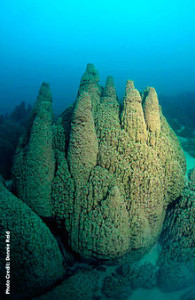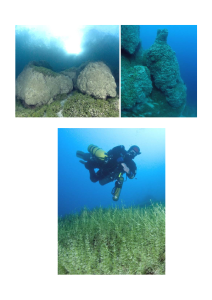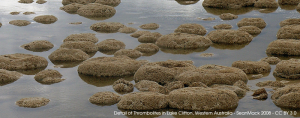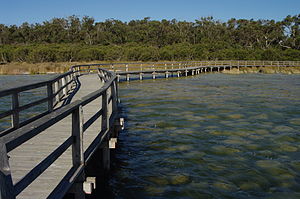From Stromatolites to Microbialites
by Steve Reynolds
During Ian Lewis’ talk about cave diving around Mount Gambier at the SDFSA’s Splash Inn event during SA Scuba Week, he mentioned the occurrence of stromatolites in the Blue Lake. This reminded me about the article Report on the Blue Lake Sediment Sampling & Research Programme February/March 2008 by Peter Horne in our MLSSA Journal for 2008.
There are considerable details and photos of the Blue Lake stromatolites in the article and the accompanying attachment “Attachment A – Geology and Geomorphology Report”.
I later posted several MLSSA links concerning stromatolites on Facebook, as follows: –
https://mlssa.org.au/category/fossils-stromatolites/
https://mlssa.org.au/2014/07/06/stromatolites-part-2/
https://mlssa.org.au/2013/09/11/thrombolites-stromatolites/
Facebook wouldn’t allow me to post these two links to our Journals though: –
http://seadragon.podzone.org/journals/2008Journal.pdf
http://seadragon.podzone.org/journal1999_index.html (2 articles)
Our March 2000 newsletter (No.264) featured my article “More on Stromatolites, Synclines and Fossils” but it is not available online.
Peter Horne, author of Report on the Blue Lake Sediment Sampling & Research Programme February/March 2008, was present at his buddy Ian Lewis’ talk. He later commented on Facebook, “These days we tend call these “microbialites”.” I now realise that I had discussed this in Stromatolites – Part 2
(Peter then added, “If anyone is interested in the Blue Lake’s other fascinating features which were also discovered by our researcher teams between 1985 and 2008, please feel free to download anything that might interest you from:
https://sites.google.com/site/cdiverepts/ “)
These microbialite towers at Pavilion Lake, British Columbia are very similar to those found in the Blue Lake: –

Sure enough, according to Wikipedia, “Microbialite is a rock or benthic sedimentary deposit made of carbonate mud (particle diameter < 5 μm) that is formed with the mediation of microbes. The constituent carbonate mud is a type of automicrite, or authigenic carbonate mud, and therefore it precipitates in situ instead of being transported and deposited. Been formed in situ, a microbialite can be seen as a type of boundstone where reef builders are microbes, and precipitation of carbonate is biotically induced instead of forming tests, shells or skeletons. Bacteria can precipitate carbonate both in shallow and in deep water (except for cyanobacyeria) and so microbialites can form regardless of the sun light.
“Microbialites were very important to the formation of Precambrian and Phanerozoic limestones in many different environments, marine and not. The best age for stromatolites was from 2800 Ma to 1000 Ma where stromatolites were the main constituents of carbonate platforms.”
The webpage goes on to give the classification for microbialites, as follows: –
“Microbialites can have three different fabrics:
Stromatolitic: microbialite layered, laminated or agglutinated to form a stromatolite.
Thrombolitic: microbialite with a clotted peloidal fabric if observed with a petrographic microscope. The density of peloids is variable. At the scale of the hand sample, the rock shows a dendritic fabric, and can be named thrombolite.
Leiolitic: a microbialite with no layering nor clotted peloidal fabric. It is only made of a dense automicrite.”
The webpage then went on to describe microbes that produce microbialites as follows: –
“Microbes that precipitate carbonate to build microbialites are mostly prokaryotes, which include bacteria and archaea. The best-known carbonate-producing bacteria are Cyanobacteria and Sulfate-reducing bacteria. Archaea are often extremophiles and thus live in remote environments where other organisms cannot live, such as white smokers at the bottom of the oceans. Eucaryote microbes, instead, produce less carbonate than prokaryotes.”
It has been a slow process but, over a number of years (20?), I have progressed from writing about stromatolites, oncolites, pisolites and thrombolites to writing about microbialites. I still haven’t yet been able to research words such as charophyte, celestite or pelsparite. Charophyta is said to be a group of freshwater green algae. Chara is said to be one of six genera of Charophyceae – “obligate aquatic algae, growing submerged in calcareous fresh water. They are distributed throughout the world from the tropics to cold temperate zones.”
Report on the Blue Lake Sediment Sampling & Research Programme February/March 2008 includes this photo of a diver hovering over a Chara bed.

The header photo features thrombolites at Lake Clifton. Here is a close-up of those thrombolites: –

Yalgorup National Park observation walkway
(Source: http://en.wikipedia.org/wiki/Lake_Clifton,_Western_Australia )
In my article “More on Stromatolites, Synclines and Fossils” (March 2000 newsletter, No.264) I stated that pisolites were “small concentrically layered structures, the result of fossilised bacteria” and that “After the Greening” says that pisolites are small pea-like nodules of ferricrete – “ferricrete —– composed of small round nodules cemented together”. The book went on to say that pisolitic ferricrete weathers into free pisolotes.
We have a file on Stromatolites in our Society library (mlssa 2324). Jim Foster wrote about the stromatolites in the Blue Lake in the Nov/Dec issue of “On the Road”. Mary E White wrote about Stromatolites in her book “The Greening of Gondwan

